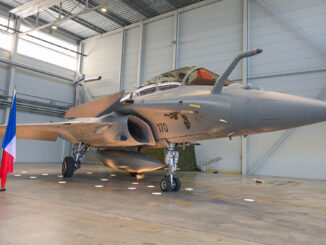 Embraer EMB 121A Xingu (c/n 121-078, 078-YE of the French Air and Space Force) on static display during the Belgian Air Force Days 2023, Kleine-Brogel, September 2023.
Embraer EMB 121A Xingu (c/n 121-078, 078-YE of the French Air and Space Force) on static display during the Belgian Air Force Days 2023, Kleine-Brogel, September 2023.
In the middle of 1960s, the Brazilian authorities decided to boost development of national aviation industry. It was expected that country´s demand for military and civilian aircraft could be met by domestic manufacturer, therefore eliminating the need of purchasing of foreign manufactured aircraft. In conclusion, a state-owned Empresa Brasileira de Aeronáutica (Brazilian Aeronautics Corporation, abbreviated as Embraer) was established on 19th August 1969.
The first aeroplane developed and produced by the Embraer company was a twin-engine, turboprop passenger aircraft designated EMB 110 Bandeirante (English: pioneer). The aircraft was designed by Max Holste, the French aviation engineer best known for his most successful aircraft MH.1521 Broussard. When his aviation company almost went bankrupt in 1960, Holste sold his assets and moved to Brazil.
An interesting fact is that, while developing the first Embraer aircraft, Holste followed the IPD-6504 specification issued by the Brazilian government in 1965. Works on the aeroplane, at that time carrying the military designation YC-95, began four years before the official establishment of Embraer. On 26th October 1968, the prototype of Holste´s aircraft performed its maiden flight.
And it was exactly the successful design of the YC-95 that eventually convinced the Brazilian authorities to create the Embraer company. Then, the aircraft received its civilian designation EMB 100 and was approved for serial production. Shortly after, an order for 80 examples of the aeroplane was received from the Brazilian Air Force. However, the initial requirements were significantly revised and led Holste to re-design the aeroplane. Its new version, now re-designated EMB 110, was much larger and equipped with more powerful engines.
Finally, a total of nearly 500 examples of the EMB 110 was built until 1990, when its production was ceased. Apart from the Brazilian military and civilian customers, Bandeirante was acquired by several small passenger carriers around the world, as well as about a dozen air forces.
Based on the EMB 110 commercial success, Embraer began development of an entire family of small cargo and passenger aircraft, named Family 12X. It included EMB 120 Araguaia, EMB 123 Tapajós and EMB 121 Xingu. All aeroplanes had to be created following modular design concept and share many of its construction elements and equipment. Their names came from three large Brazilian rivers.
On 10th October 1976, prototype of Xingu performed its maiden flight. The EMB 121A was a small utility low-wing aircraft, able to carry up to nine passengers and powered by two turboprop Pratt & Whitney Canada PT6A engines. Its wings and engine nacelles design were based on the EMB 110, although with reduced wingspan.
The first serial manufactured Xingu was ready in May of 1977. Later that year, the EMB 121 was exhibited at Paris Air Show but failed to gain any interest. The same happened with consecutive development variants of – 121A1 Xingu II, with more powerful engines and 121B Xingu III, stretched version of the aircraft.
Finally, the EMB 121 was built in only about 100 examples and its production was ceased in 1987. The majority of the aircraft were bought by only two customers, the Brazilian and French ministries of defence.
In 1980, the French MoD chose Xingu as training aircraft for the then French Air Force and the French Naval Aviation. The delivery contract covered forty-one examples of the EMB 121 – twenty-five for the FAF and sixteen for the Navy. Many of them remains in the French service until today and, apart from the initial training role, they are currently used as liaison aeroplanes.
Development of the EMB 123 Tapajós airliner, able to carry up to ten passengers, was quickly abandoned and replaced by the aforementioned Xingu III which – by the way – was also unsuccessful. The EMB 120 Araguaia had to be a 24-seat aeroplane of the Family 12X, but it soon turned into even larger airliner, EMB 120 Brasilia, able to carry up to thirty passengers. That aircraft eventually achieved commercial success, however, new design of the EMB 120 lost the most of its commonality with the EMB 110 and the Family 12X.



